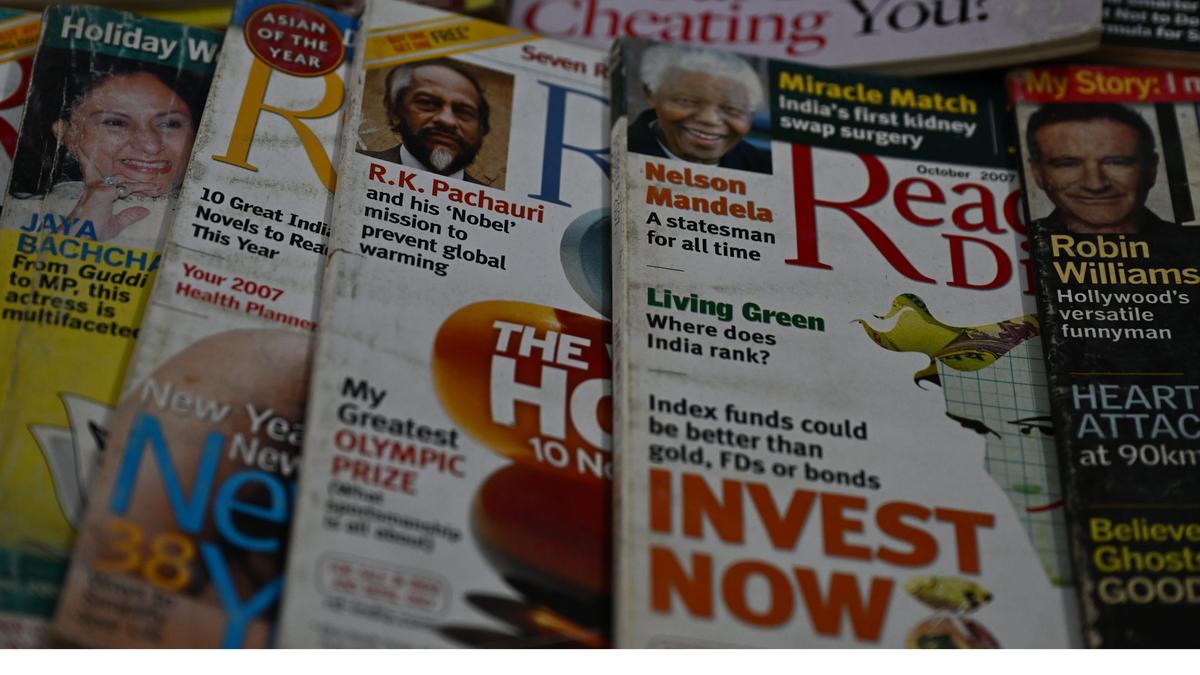
Some of the Reader’s Digest issues in K. Balasubramaniyan’s collection, in Tiruchi.
| Photo Credit: M.MOORTHY
Bookish folks of a certain age sighed remorsefully when they heard of the UK edition of Reader’s Digest (RD) permanently going off the stands from June after 86 years, owing to financial pressures. In India, the magazine holds a special place in the hearts of readers who grew up in the pre-internet era, as RD gave English-loving families a window to a world outside their own.
“There was a time when Reader’s Digest was publishing books on health, general knowledge, nutrition and dictionaries that stood out not just for their content, but their layout, colour photography and paper quality. Even the binding on these books was superb, and stayed intact,” says K. Balasubramaniyan, an engineer-turned-author, environmentalist and book collector who maintains a library of 1,50,000 books, five lakh magazines and 10 lakh back issues of newspapers at his family home in Tiruchi’s Thillai Nagar neighbourhood.
Balasubramaniyan recently received a gunnysack full of RD from a friend, and is busy sorting them out when we meet. “I was so sad to learn that the British edition is closing down. With the growth of electronic media, nobody seems to have the time to read physical books. I hope someone will re-publish popular issues of RD for a new generation of readers,” he says.

Book collector K. Balasubramaniyan with some of the special publications brought out by Reader’s Digest, in Tiruchi.
| Photo Credit:
M. MOORTHY
The original aggregator
First published in 1922, by American couple DeWitt Wallace and Lila Bell Wallace, Reader’s Digest began as a US-based pocket-sized compendium of condensed articles taken from other periodicals. In many ways, RD could be called the original aggregator, breaking reading material of topical interest and entertainment value into capsules of information that appealed to a wide range of public tastes.
For several decades, says a Wikipedia page, RD maintained a format of 30 articles per issue (one for each day of the month), including columns such as ‘It Pays to Increase your Word Power’ vocabulary quiz, a page of ‘Amusing Anecdotes’ and ‘Personal Glimpses’, funny stories entitled ‘Humour in Uniform’ and ‘Life’s Like That!’, among others.
The Indian and Pakistani editions were launched in 1954, and some of its earliest fans credit RD for introducing them to Western literature. “RD was part of my English reading, from the 1950s, and we had a whole library of ‘Condensed Books’ published by them at home,” says retired High Court judge Prabha Sridevan. “Circulating libraries were not common in Chennai at the time, so most of the magazines would be given away at the end of the month. My father wrote a joke for the Life’s Like That! column.”
“I read books like Rebecca, 39 Steps and other lovely titles in the Condensed version series,” says the septuagenarian.
Inherited collection
My senior colleague Saraswathy Nagarajan from Thiruvananthapuram is an avid fan of RD, having inherited a vast collection of over 200 issues from her grandfather and father. “I remember reading a profile of Amitabh Bachchan in Reader’s Digest. The article on Nek Chand’s rock garden in Chandigarh was another memorable one, especially when I had an opportunity to visit the city much later. Sometimes I lose myself looking at the advertisements carried by RD in the Indian editions — it is like a time machine,” she says.
As a professional journalist, Saraswathy says RD taught her the art of writing effectively. In retrospect, however, a more nuanced understanding of the stories featured in the magazine exposes hidden agendas, she says. “When you read them today, there seems to have been a bias towards the capitalist and Westernised viewpoints in many articles. Whether in the survivor stories or political suspense unfolding during the Cold War, readers were being told about the prevalent American stand.”
An addictive pleasure
Yercaud-based hotelier Vishu Kaliappan started reading RD at the age of 12, prompted by his mother, a bookworm herself. “The best thing about Reader’s Digest was its size. It would fit in the palm easily, with a snack, which was really cool when I was growing up. I also enjoyed its humour and vocabulary columns. Of course, as we began to get more exposure through television and later the internet, RD began to feel dated. Parents would often subscribe to the magazine mainly to improve their children’s English skills outside the school syllabus.”
Vishu is now hoping to build a collection of vintage Reader’s Digest magazines for the guests who visit his resort in Yercaud. “The magazine’s design stood out from others in the market at the time. The articles were presented in a light style that would energise the reader. I found it quite addictive, and could not stop until I had read all the articles in each issue.”
#Readers #Digest #favourite #generations #magazine #lovers



